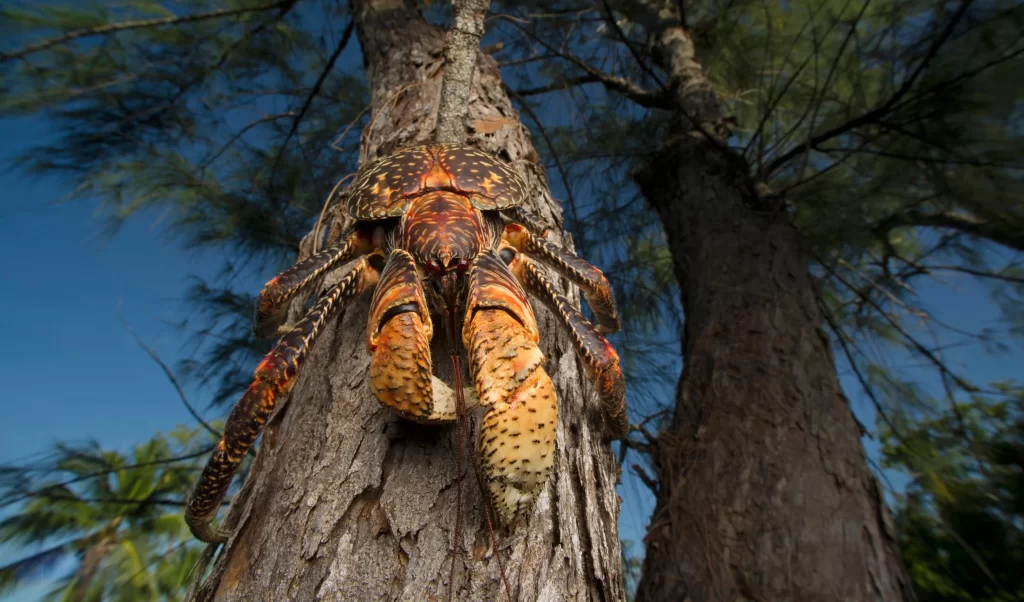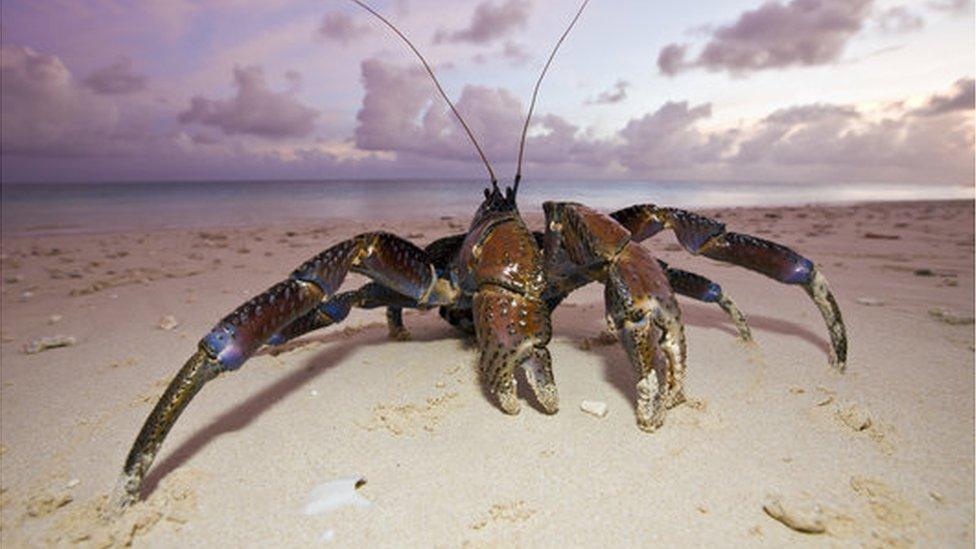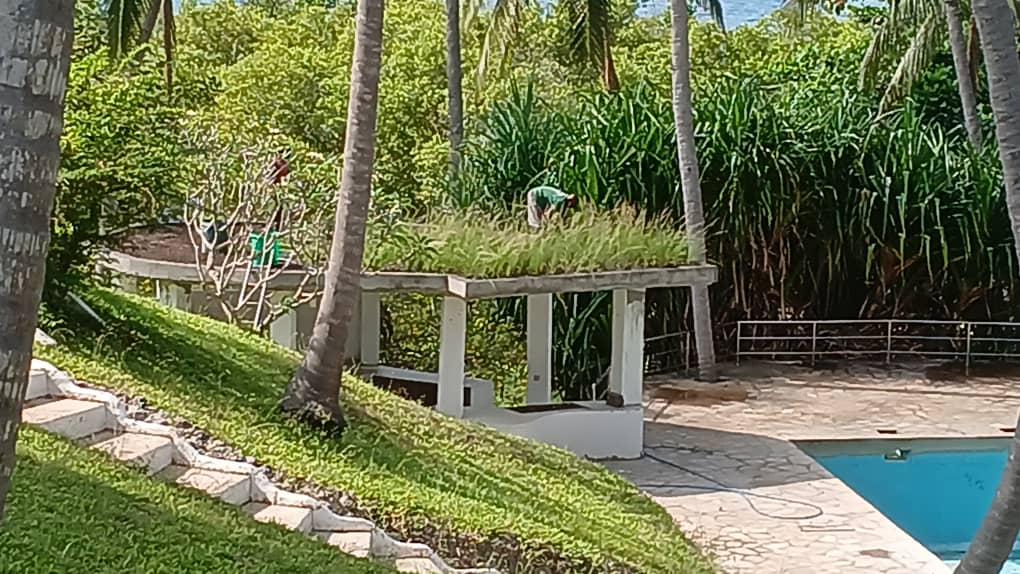When one thinks of Mafia Island, the mind often drifts to visions of sun-drenched beaches, turquoise waters, and a laid-back island lifestyle. However, beyond its famed marine life and coral reefs, this Tanzanian gem harbors a lesser-known resident—the coconut crab (Birgus latro). These elusive giants, the largest terrestrial arthropods in the world, add an extra layer of intrigue to the island’s biodiversity.
The Coconut Crab: A Brief Introduction
Nicknamed the “robber crab” or “palm thief,” the coconut crab is the world’s largest land-dwelling crustacean, capable of growing up to a meter in length from leg to leg and weighing up to 4 kilograms. They are close relatives of the hermit crab but have outgrown the need for shells as they mature. The coconut crab gets its name from its unique ability to crack open coconuts—a skill that’s not just impressive but crucial for its survival.
Interestingly, these crabs come in different color morphs depending on their location, ranging from deep purple to bright red . Despite their name, coconuts are not a significant part of their diet but are rather an occasional treat. Instead, they feed on fallen fruits, nuts, seeds, and carrion.
Masters of Adaptation
Coconut crabs are marvels of evolution, perfectly adapted to their terrestrial lifestyle. Unlike their ocean-bound cousins, these crabs have specialized lungs instead of gills, allowing them to breathe air. This adaptation means they cannot swim and would drown if submerged for too long .
Their powerful pincers can exert enough force to crush coconuts, break open hard fruits, and even—brace yourself—snip off a finger if you’re careless! These nocturnal creatures are rarely seen during the day, preferring to stay hidden in burrows or rocky crevices to avoid predators and the intense heat of the equatorial sun. At night, they emerge to scavenge, using their keen sense of smell to locate food from great distances.

Conservation Status and Threats
Unfortunately, these incredible creatures are not immune to the pressures of human activity. According to the IUCN Red List, coconut crabs are classified as Vulnerable due to a significant decline in their population over the last few decades . Habitat loss, overharvesting for food, and road kills are some of the primary threats they face. The crabs are slow-growing, taking up to five years to reach maturity and potentially living up to 60 years. This slow life cycle makes it difficult for populations to recover once depleted.
In regions like Mafia Island, coconut crabs are hunted for their meat, which is considered a delicacy. Moreover, the increasing human population on islands has led to habitat destruction and competition with invasive species like rats, which prey on young crabs .
The Importance of Coconut Crabs in Mafia Island’s Ecosystem
Mafia Island’s lush mangroves, coastal forests, and remote beaches provide an ideal habitat for coconut crabs. These creatures play a vital ecological role, acting as nature’s recyclers by consuming organic matter and carrion. Their presence indicates a healthy ecosystem, which is a testament to Mafia Island’s relatively untouched natural beauty.
However, conservation measures are essential to ensure their survival. Active protection, like that seen in places like Chumbe Island and Aldabra Atoll, has been successful in maintaining healthy crab populations . On Mafia Island, sustainable tourism practices are crucial in preventing further decline.

Encountering Coconut Crabs: A Unique Experience for Eco-Tourists
For adventurous travelers, encountering a coconut crab in the wild is a bucket-list-worthy experience. Whether it’s during a moonlit beach walk or a guided tour through the island’s coastal forests, the sight of these prehistoric-looking creatures scuttling across the sand is something you won’t forget.
However, remember to observe from a distance—these crabs are shy but can become defensive if provoked. While their powerful pincers are a marvel of nature, they’re best appreciated from afar (preferably with all your fingers intact!).
Conservation Efforts and the Future
Mafia Island is more than just a diving paradise; it’s a sanctuary for species like the coconut crab, which faces threats in other parts of the Indian Ocean due to hunting and habitat destruction. Local conservation groups, often in collaboration with eco-lodges, are working to protect these unique creatures through community education and sustainable practices.
Key Conservation Measures:
1. Establishing protected areas where crabs can breed without interference.
2. Introducing legal restrictions on harvesting, especially during breeding seasons.
3. Promoting community-driven conservation initiatives to raise awareness about the importance of preserving coconut crabs .
By supporting these efforts, eco-tourists can play a vital role in ensuring that future generations can experience the wonder of seeing a coconut crab in its natural habitat.
Conclusion
Mafia Island is a treasure trove of natural wonders, and the coconut crab is a symbol of its ecological richness. Beyond the island’s pristine beaches and stunning reefs lies a world filled with unique species that continue to captivate the curious traveler. By exploring responsibly and supporting conservation efforts, you can be part of the journey to protect this magical island and its fascinating inhabitants.
Author’s Note: If you ever find yourself on Mafia Island, venture beyond the obvious and explore the secrets it holds. You might just find yourself face-to-face with a coconut-cracking, tree-climbing marvel that you’ll be telling stories about for years to come.
Photos by Todd Gustafson



